Attatchments:
Score with annotation
First movement:
Exposition
(part 1: mm. 1-215)
Score with annotation
First movement:
Development & Retransition
(part 2: mm. 216-330)
Score with annotation
First movement:
Recapitulation
(part 3: mm. 331-556)
Schubert: Symphony no. 1 in D major, D 82. first movement – An analysis
Introduction
Schubert wrote his first symphony in October 1813 at the age of sixteen, the very month in which he decided to turn down an endowment granted to him by emperor Franz I and to devote his life to music. This symphony was completed on the 28th of October 1813 and was dedicated to the director of the Konvikt, Dr. Franz Innozenz Lang. This analysis covers the first movement of the symphony.Practical information
In this text a lot of references are made to the score of the symphony. This is done by means of an identification of a part number and the measure number. Right from this text you will find links to pdf files with parts of the score. The subdivision is made because of restraints on the size of pdf files. The measure numbers in each part are indicated so it will be easy to find the right part to open. Moreover, the parts of the score correspond to sections of the movement. The score contains a lot of annotations on my behalf. A clean score can easily be downloaded from IMSLP. The most convenient way to digest the text is to open the text and the score each in its own window (not tab) and place these windows next to one another so you can browse the score as you read the text. This is best done on a computer as this provides enough space to place these windows next to one another. The most easy way to do this is to open the score and down load it and open it in a PDF viewer or any preview program. Then size the score window to half the size of your screen. Open the relevant part of the score and then return here and continue reading. Consulted literature provides the list of books and articles I used analyzing this piece. The musical examples are made in Musescore 3. Have fun reading it and please leave your comments at the end of the post. Most terms and abbreviations used are in accordance with those used in Steven Laitz: The Complete Musician, a comprehensive textbook on these matters.First movement: Adagio – Allegro vivace
Introduction: Adagio
[here you should open the score part 1] The Adagio starts with a chromatic descending bass line from 1 to 5 in mm 1-9. This descending tetrachord is sometimes called Lamento bass. It occurs already in Schubert’s Fantasie in C minor, D 48 of april-june 1813 for piano duet. The harmonisation is pretty straight forward. Essentially it’s about the tonic, the dominant, the sub-dominant in major and minor (mm. 7-8) and the applied dominant to IV (m. 5). In m. 9 the dominant is reached and expanded just to the beginning of the Allegro vivace. Schubert introduces the lowered 6, first in m. 12 in a melodic mixture to alter the IV to minor (iv), then again in m. 16 as the root of a bVI chord (a harmonic mixture) used as the upper neighbour of the dominant. Other means to expand the dominant are the cadential six-four chord in m. 14 and the diminished seventh chord of the dominant in m. 18. From measure 12 onwards we find an ascending line from 5 to 1 and subsequently a descending line from 1 to 5 in the first violins with a short counter movement in the flute (mm. 13-15). This is the harmonic D minor scale which we will come across later on in the Retransition. So the Adagio consists of two phrases the first of which (mm. 1-11) is made up of the punctuated ascending triad figure followed by the descending triads in eight notes. Starting in m. 7 the motive is contracted and leads to the second phrase starting in m. 12. This is in fact one big upbeat in V which announces the firm first subject in D major in the Allegro vivace.First movement – Allegro vivace
This part is in sonata form and the constituent parts are as follows (the Adagio is included because it reappears in the recapitulation):The First Tonal Area (FTA)
The first tonal area contains 32 measures (mm. 21-53). To decide on the form we can look along two axis, the melodic and the harmonic axis. The first theme recurs at bar 37. This suggests melodically a division of the FTA in two parts and indeed, the two phrases (mm. 21-36 and 37-53) are almost identical, except for the instrumentation and the last four measures (mm. 49-52). Anticipating the final form we’ll call these phrases the antecedent and consequent and the form of the FTA as a whole a period. To confirm that it is indeed a period we look at the harmonic plan Schubert uses. The FTA starts of course in D major and the end of the antecedent (mm. 33-36) shows a half cadence (HC) and thus ending on the dominant. The consequent continues on I (m. 37). The consequent ends (mm. 49-52) with an imperfect authentic cadence (IAC) in B minor (vi), the relative key of D major. This harmonic plan implies a progressive Parellel Interrupted Period, a progressive PIP, which is explained as follows: because the melodic material in the two phrases (antecedent and consequent) is very similar the period is called parallel. The HC at the end of the antecedent and the restart on I in the consequent make it interrupted. And the fact that the period ends with an IAC in another key than the tonic makes it progressive (see fig. 1).The antecedent and the consequent
Closer inspection of the two constituent phrases of the period reveals another structure at a deeper level. As has been indicated in the score, the antecedent consists of a four bar motive starting on I (indicated with A) which is repeated starting on V (indicated with A’) and then a statement of eight bars (indicated with B). This structure which consists of two short units and a longer unit in the ratio 1:1:2 is known as a sentence. The consequent consists of the same structure, be it that the last 8 bar structure (indicated with B’) ends differently from its counterpart in the antecedent. So both antecedent and consequent consist of a sentence and thus the period as a whole consists of two repeated sentences. A final decomposition concerns the B part of the afore mentioned sentences. These consist of units in the same ratio as the sentence on a higher level: a two bar motive which is exactly copied (indicated with c) and then a four bar phrase (indicated with d) which concludes the sentence structure. So the sentences at the level of antecedent and consequent contain another sentence in the B-part; this is called a nested sentence structure. In conclusion the FTA consists of two repeated sentences (the antecedent and the consequent) and both these sentences contain a nested sentence in the last part of their constituents (fig. 2).
A final remark concerns the end of the consequent or more specific the last part of the nested sentence of the consequence (indicated with d’, mm. 49-52). As mentioned before Schubert deviates here from its counterpart in the antecedent by repeating the motive indicated with c a semitone higher and thus moving to a rather indecisive cadence in B minor – the relative key of D major – which ends on the second inversion of the new key (m. 53). Because of the indecisiveness this is rather a tonicization than a modulation. This leads to the next section of the exposition: the Transition.
The Transition (ITr)
The transition – the section between the first and second tonal area – does not build on the thematic material of the first tonal area and is therefore called an independent transition and abbreviated as ITr. After the rather weak statement of B minor in m. 53 Schubert proceeds immediately to the dominant of B minor which is the starting point of a descending sequence to return to D major in m. 62 (which is III in B minor). A sequence or harmonic sequence consists of a model and one or more copies. In this sequence the model consists of the measures 54-58 and the only copy is found in the four measures that follow. The sequence is of the type D2(-3/+2), that is first descending with a minor third and then ascending with a minor second resulting in a descent of a major second (D2). The start of the sequence on F# in m. 54 is reached through its applied diminished seventh chord on Es in the second inversion in the second half of m. 53. The Fs is prolonged three bars and then follows a decent of a minor third to Ds in m. 57. This is the end of the model. The copy starts in m. 58 with an ascent of a minor second to an E minor chord in first inversion. Like in the model the E minor chord is prolonged three bars and followed by a descent of a minor third to C#. This again is followed by an ascent of a minor second and the D major chord is reached in m. 62, being a III in B minor. Here the tonicization ends and we’re back in D major. This is quite an elegant sequence as the chords after the leaps downwards of a minor third are always the diminished seventh chord of the harmony to come and can also be seen as a neighbour of these chords. The D# chord in m. 57 is the vii04/3 of the E minor chord in m. 58. The same holds for the C# chord in m. 61 with respect to the D major harmony in m. 62. So this sequence brings us back from the dominant of B minor to the first inversion of III, which happens to be the tonic of the movement (D major, the relative key of B minor). The D major is prolonged for 3 bars with the aid of some inversions of the dominant (m. 63) and then modulates to V (A major) which is the key of second tonal area (STA). The root of the new key is a sustained pedal above which the tonic and minor seventh cord alternate until the pedal six-four takes over the alternation (mm. 70-72). Then follows a nice cadence in the woodwinds and the STA is reached.The Second Tonal Area (STA)
The second tonal area is in A major, the dominant of the main key and spans 20 bars. It consists again of a period of which the antecedent is eight bars (mm. 78-85) and the consequent 12 bars (mm. 86-97). The melodic material is very similar, as a matter of fact identical for the first seven bars of the two phrases, except for the accompaniment and instrumentation. Therefore it is a parallel period. When looking at the harmonic content of the period we find that the antecedent closes on a rather strong cadence (mm. 85-86) but the last beat of m. 85 is a V chord which is not in root position. Therefore this is an IAC. The consequent ends with an even stronger cadence in which the dominant is in root position (m. 96). So this is a perfect authentic cadence (PAC). For the section to be a period the cadence of the consequent needs to be stronger than the cadence of the antecedent, which is the case. Because of the cadence at the end of the antecedent and the start of the consequent on I this period is called sectional. So the STA is a Parallel Sectional Period (PSP). The diagram is shown in fig. 3.
When looking closer at the antecedent and consequent it becomes clear that both are sentences of which the A and A’ part consist of a two bar motive. The B part of the antecedent consist of four bars (fig. 4) but the B’ part of the consequent has an extra four bars (fig. 5) with a more elaborated cadence with the applied seventh chord of the predominant (m. 93), the predominant (m. 94), the cadential sixth-four chord (m. 95) and then dominant and tonic.
Closing Section
The exposition ends with the so called Closing Section and a Codetta. The Closing Section will be indicated with CL-E (where the E stands for Exposition as opposed to CL-R, the Closing Section of the Recapitulation). As can be seen from table 1 the Adagio, FTA, ITr and STA take up 97 bars and the closing section takes up 106 bars (not including the codetta which consists of another 10 bars). So Schubert takes this section seriously and as I will try to show he is experimenting with variations on the melodic material of the second tonal area and with different harmonisations of that same melodic material. The closing section can be seen as a reinforcement of the new key (i.e. the key of the second tonal area), in this case A major, or V of the main key of the movement. And indeed the whole closing section is in A major but this young Schubert takes us on an interesting journey before he reaches the final cadence in the codetta. To make things more comprehensible I distinguished a number of segments within the closing section as shown in table 2. The segments are given a name/description and a number to make references easier.
The various motives and there names are listed below. First of all we have the first motive of the second tonal area, the STA-A motive (fig. 6; mm. 78-80). The second motive to distinguish is the first part of the B-motive of the second tonal area (fig. 7; mm. 82-84). This will be called the STA-B motive.
Four motives come from the closing section. It is the CL-ext motive (fig. 8; m. 100), and the inversion of this motive: the CL-ext-inv motive (fig. 9; m.121).
And a short stylised version of the STA-B motive of which only the ascending triad is left which will be indicated with STA-B-styl (fig. 10, m. 180) and its inversion STA-B-styl-inv (fig 11, m. 182).
Closing section of the Exposition: Segment 1
The first segment of the closing section starts with the STA-A motive. Then follows the CL-ext motive. This melody as a whole (mm. 98-101) is used in a A2(-3/+4) sequence of which the whole of the first segment is made up. The sequence consists of a model and three copies and leads from the tonic (A major) up to the dominant (V7) in m. 113. Notice that the model consists of a four bar phrase in which the harmony changes once. So we have two different harmonies in the model and each copy: a two chord sequence. The melody is played by the first and second violins with a comment from the high woodwinds (flute and hobo).Closing section of the Exposition: Segment 4
Now let’s look at segment 4 of the closing section (mm. 142-152). Schubert uses the same melody but now played in the low strings and bassoon. The only difference is the last bar of the phrase in which there is not an appoggiatura before the next harmony is reached (compare m. 101 with m. 145). Again Schubert introduces a sequence, this time to take us from I to the major VII in m. 157 which is by itself already something to look into. This sequence, which consists also of a model and three copies is amazingly different from the one in first segment.Score with annotation
First movement:
Exposition
(part 1: mm. 1-215)
Score with annotation
First movement:
Development & Retransition
(part 2: mm. 216-330)
Score with annotation
First movement:
Recapitulation
(part 3: mm. 331-556)
As shown in fig. 12 the model starts in m. 142 on the tonic (I). In comparison to the sequence in segment 1 this is one bar later with respect to the melodic line. It will be shown why this is necessary. After the tonic it touches vi in m. 144 and lands on IV in m. 145. So the model consists of a four bar phrase and within that there is a three step harmonic rhythm. From one occurrence of the model to the next the distance is an ascending major second; that’s the “A2” in the label of the sequence. Then within each occurrence we find two harmonic steps, one step down a (minor) third and one step up a (minor) sixth. The step to the next iteration is again a descending minor third. To make sure that each occurrence follows this rhythm the sequence has to start in m. 142. So this is a three chord sequence which is labeled as A2(-3/+6/-3). Now let’s take a closer look at the harmonic progression from the model to the first copy and then to each subsequent copy. The model starts on I6 in m. 142. The first copy starts in m. 146 on ii6, the third copy starts in m. 150 on iii. So far, so good. But then look at the fourth copy: we expect IV here (a D in stead of a D# being harmonised with IV) which would fit nicely in the sequence I, ii, iii. But instead Schubert proceeds to vii0/V, that is a diminished triad on D#, which is the triad on 7 of the dominant, E major. The next two steps confirm the relation to the dominant. First there is a descent of a third, but this time a major third, from D# to a B major chord, being the dominant of the dominant (V6/V). And then there is the ascending major sixth to the G#. This could have been harmonised with an E major chord, and then the dominant would have been reached as we expect of a sequence of four steps starting on A. But instead the chromatic adventure is continued with a G# major chord, rather a long way off track from A major. It is a VII in this key. So we have a model and two copies which are perfectly diatonically but then in the third copy Schubert wanders of to a short chromatic detour which makes this repetition of already known melodic material even more interesting.
In fig. 13 the course of the harmony is shown. Repeated harmonies are left out and all chords are in root position. The colours indicate the sustained notes from one chord to the next.
After the G# major chord a return is made to a B major chord, being the dominant of the dominant and within seven bars we are back to I, A major (m.165). This ends the fourth segment.
Closing section of the Exposition: Segments 2 and 3
And what happens between the first and fourth segment we have discussed thus far? After the sequence in the first segment there is a change of roles (segment 2, mm. 113-120). The comment of the woodwinds now appears in the first and second violins and a reminiscence of the CL-extension is played by the high woodwinds. This is supported by a sustained chord in the violas on B and D. These notes fit nicely in the dominant V7 (E-G#-B-D) and its expansion: vii02 (G#-B-D-F). Then an interesting episode occurs: CL-ext-inv motive is played by the clarinet and bassoon (segment 3, mm. 121-141). The harmonic plan is as follows: V9-vi-IV-ii-I64- viio7/V-V7-I. The vi and IV are preceded by applied V and vii0 chords. This whole passage can be seen as an extended and elaborated cadence in which one single motive is used. The I is reached in m. 141.Closing section of the Exposition: Segment 5
In segment 4 the sequence reached the major VII chord in m. 157 and segment 5 (mm. 158-165) brings us back once more to the tonic of A major in m. 165. The first violins play repeatedly the motive of the first half of the STA-B motive which I have called the stylised STA-B motive.Closing section of the Exposition: Segments 6 and 7
The next two segments (6 and 7, mm. 166-191) double a lot of the material we have seen so far in the closing section. Segment 6 (mm.166-179) is a variation on the motives STA-B-styl and CL-ext, extensively used in segments 1 and 4, this time not in a sequence but again with a harmonisation on VII. Segment 7 (mm. 180-191) uses the STA-B-styl motive in a question-answer game between first violins and low strings and ends with something of a coda (mm. 187-191). Perhaps this doubling is the reason that in some recordings the segments 6 and 7 are cut out. This is marked this in the score.Closing section of the Exposition: Segment 8
Before the codetta there is one more segment left (no. 8, mm. 192-206). Here Schubert does the same as in segment 7; he uses the STA-B-styl and the STA-B-styl-inv motive in a question-answer game between first violins and low strings. The start in m. 192 equals m. 180. Both set out on a chromatic ascending baseline. The one in segment 7 only climbs to B in m. 183 and then follows the dominant. In segment 8 the baseline runs from A in m. 192 to D in m. 201. The A# diminished seventh chord in m. 182 (segment 7) can be seen as an applied chord to the following ii in m. 183. In m. 193 we see the same diminished seventh chord on A# but here it is followed by an E minor chord and this leaves the diminished seventh chord A# somewhat hovering. Noteworthy is perhaps also the altered mediant in m. 197 to harmonise the C natural in the chromatic ascending base line. The lowered 7 comes natural as the key signature is still that of D major (the main key of the movement). After the chromatic ascending base line which ends at IV the I at the beginning of the codetta is reached by way of a ii and a V6/5.Closing section of the Exposition: The Codetta
The codetta is one big cadence in A major and this ends the exposition. So we have seen that Schubert uses the motive of the second tonal area in various forms extensively in the closing section. Melodically he alters, inverses and simplifies it; harmonically he reuses the constructed melodic material and experiments with various harmonic structures. And this is only the closing section of the exposition. The development is yet to come.Development
[here you should open the score part 2] The Development section consists of 85 bars (mm. 216-300). This is the section to play with the material of the exposition. As we have seen Schubert already did his share of playing around in the closing section and primarily with thematic material of the second tonal area. The development section is not different in that it contains material from the second tonal area and the closing section. When looking at the development section there are again some segments to distinguish (table 3).Development: Segments 10 to 12
The development starts with three statements of the complete theme of the second tonal area (the segments 10-12). All three statements have an extended B-part. The first time (segment 10) the theme is stated in the flute and clarinets in A major. The B-part is two measures longer (six in total), so the ratio A:A’:B is 1:1:3. In fact it equals the statement of the B-part in the consequent of the second tonal area without the mm. 93-94. The second time (segment 11) the hobo plays the theme joined by the bassoon in the B-part. This time the key is A minor and the B-part is again extended by two more bars making a total of 8 bars. The ratio A:A’:B is 1:1:4. The extra two bars (mm. 233-234) are added again where they were in the consequent of the second tonal area. Schubert harmonises them with III preceded by a VII65 which should be read as a V6/5/III (m. 232). The third and last time (segment 12) the theme is again played by the flute and clarinet. It starts in A minor and the A and A’-parts are stated as before. The B-part here consists of twelve bars (mm. 242-253). The first eight bars are melodically and harmonically identical to those in segment 11. Then Schubert takes us from VI (F major) in m. 243 to I in m. 251. The label of the sequence this time is A2(-4/+5), which means that it is stepwise ascent from F through G (m. 247) to A. In fact I am cheating here: look at m. 244. This is also a G major chord as in m. 247 but this time I spell it as V6/5/III and therefore I choose to ignore it. So the G major chords have two different functions here: one is target in the ascending sequence, the other is an applied dominant. In the same way m. 248 in the copy of the sequence, the V6 of the IV to come. It is a A major chord which has the suggestion of dominant seventh chord because of the suspension of the G in the flute and clarinet. In m. 251 it is the target in the sequence. Once the I is reached (and the switch form A minor to A major has been made on the way) it is immediately transformed in the IV of the upcoming E major. So this is the pivot chord in the modulation. When looking at the movement as a whole the harmonic progression is from D major to its dominant A major and then in this section to the dominant of the dominant E major. As we shall shortly see that is as far from home as we get in this movement.Development: Segment 13
The next segment (no. 13) is a short one. From m. 254 to m. 261 it contains only eight bars. It is named separately because of the combinations of motives we find in this section and in the next. In segment 13 we only find the STA-B motive in the flute, clarinet and first violins. The key is E major which is strongly supported by a pedal in seven voices: trumpet, trombone, bassoons, violas, celli and contrabasses.Development: Segment 14
Then in segment 14 the STA-ext-inv motive occurs simultaneously with the start of the STA-B motive. The STA-ext-inv motive is played by the bassoons and low strings. The harmony is a continuation in E major still supported by a pedal on E but now only in the trumpet and the trombone. This pedal is sustained through an augmented IV six-five chord with an added f3 (Ger65: f6-1-f3-s4) in mm. 269-272 – the function of which is predominant – but then ends as the dominant of E major comes around in m. 273 (a B major chord). This leads not as expected to a return to E major (which would be spelled as the V/IV, the dominant of IV) but to the first replacement of that dominant: vii07/IV. Nice, and this leads as expected to IV, which happens to be A major in m. 277. This is the pivot chord between E and A major and we are back in A major which is again supported by a pedal, this time an A of course. Schubert confirms this after an extension with iv6/4 with a cadence like phrase in mm. 285-289.Development: Segment 15
The real cadence follows in the last segment of the development (segment 15, starting in m.290). Here the STA-B motive in the violins alternates with the STA-ext-inv motive in the hobo and clarinet and finishes the development section. Although harmonically the development wanders off a little further than the closing section I think that the closing section is more adventurous than the development section because Schubert plays around with multiple sequences. However this may be valued, the next section is reached which will bring us back to the restatement of the opening op the symphony.Retransition
The retransition is the section between the development and the recapitulation and brings us back from whatever key the development ends in to the main key of the movement. In this case the development ends in A major in m. 301 and the retransition, starting in m. 302, will lead to D major in m. 331 where the Adagio begins the recapitulation. This retransition is quite interesting. The instrumentation is for woodwinds only of which only the hobos have two voices. So it is a pretty thin orchestration. The bassoon plays a pedal on an A that keeps running the whole retransition. The A of course being the root of the key in which the development ends and the dominant of the key to return to: D major.Brought home by means of the descending harmonic D minor scale.
Then turning to the flute we see initially a four bar phrase, starting in m. 303 that is three times repeated after the initial statement. These phrases consist of two times two bars. The first two bars are in fact double neighbour notes around the main note which ends each phrase. When looking at the main notes (which occur, after a suspension, in the second half of the mm. 305, 309, 313 and 317), we see a descending scale. This turns out to be the harmonic minor scale of D which starts in m. 305. We saw this also in the introductory Adagio. As of m. 319 the first two bars of the phrase are left out and only the “suspension” (which turns into an appoggiatura respectively an accented neighbour note) and the main note are left. But the harmonic minor scale continues and reaches the low D in m. 325. So the retransition lands on D minor before the final cadence in mm. 327 brings us to the recapitulation in D major in m. 331. For this reason and the fact that the whole retransition exists of the descending harmonic D minor scale, I think the whole retransition is in the key of D minor as indicated in bar 301.Harmonic sequence D2(+2/-3)
Closer inspection of the four times four bar phrase starting in m. 303 shows that this is again a sequence and like the sequence in the transition (ITr) it is again a descending sequence by steps of a second but this time the subdivision is first an ascending step of a second and then a descending step of a third. Accordingly the label of the sequence is D2(+2/-3). As an example the model and the first copy are explained. The model starts in m. 303 with a C# diminished chord which changes over in a D minor chord in the second half of the model (m. 305), an ascending step of a second. Then a descending step is made of a third to start the first copy on Bb major (or VI) in m. 307. The second half of the copy is harmonised with a C# diminished chord again, an ascending step of a second. The same procedures holds for the second and third copy. Note that it is important to decide which A’s to take into account to determine the harmony. If the A functions as pedal note, it should be discarded, if not it should be taken into account. The sequence takes the C# diminished chord (which is in fact a vii07 of D minor) in m. 303 down to the dominant in m. 317. As already mentioned the descending scale is continued in a contracted form. In fact this is just a descending harmonic minor scale of D in which each note is supported by its own triad. This is true also for upper half of the scale as we can see in the score (mm. 306 thru 318). There are two more details worth mentioning. The first is the voice crossing between the flute and clarinet in the first half of the model and each copy of the sequence. And the second concerns the notes played by the hobos. They play the same notes in the last two bars of the model and the first two bars of the first copy and the same goes for the last two bars of each copy and the beginning of the next. The construction can be explained as follows: as seen in the explanation of the sequence the step between the last chord of the model and the first chord of copy 1 is a descending third. The end of the model (being 1) is harmonised by its triad D-F-A (m. 306). I abstract here from the inversions. A third down is the 6, and the seventh chord on 6 is Bb-D-F-A which has three notes in common with the triad on 1, of which the hobos are playing two: the F and A. So by taking the triad on a scale degree and adding the third below it, the chord is changed to a seventh chord of that scale degree a third lower.
And that is exactly the step that is being made in the D2(+2/-3) sequence between copies. This is shown in figure 14.
The notes of the hobos are displayed in red, the descending harmonic minor scale of D in blue. The pedal of the bassoon is green.
After reaching the low D in m. 326, the final cadence in mm. 327-331 finalises the return to D major in m. 331
Recapitulation
[here you should open the score part 3] In the Recapitulation the Exposition is restated. The general rule is that all ingredients that recur are stated in I (D major), the main key of the movement. As we might expect a lot of repetition I will only address the differences that occur with the counterpart in the exposition.Adagio
The recapitulation starts with the same motive as the Adagio with which the symphony starts. But where is the designation Adagio or any indication that the tempo should be slower here? There isn’t any! The Allegro just continues. The trick is that Schubert wrote the notes in the Adagio in the recapitulation (further referred to as: Adagio-R) twice as long as the corresponding notes in the Adagio of the exposition (Adagio-E). The first note of the Adagio-E is a half note, the first note of the Adagio-R (m. 331) is a whole note. As a result in the Adagio-R twice as much bars are needed as in the Adagio-E. Look at the two bar motive at the beginning of the symphony; it corresponds with first four bars of the Adagio-R. So, as the Adagio-E consists of twenty bars we expect here an Adagio-R of forty bars, but that is not the case. Adagio-R contains only thirty bars. Closer inspection shows that mm. 1-11 correspond exactly with mm. 331-352, and the end (mm. 19-20) corresponds with the last four bars of the Adagio-R (mm. 357-360). So in between there must be the difference. And indeed where in the Adagio-E in mm. 12-18 is the harmonic D minor scale phrase, in the Adagio-R there are only four bars (mm. 353-356) which extend the dominant with a vii02 chord which is a neighbour chord of V. The punctuated motive starts immediately (m. 353) and occurs only four times. The seven bars in the Adagio-E are replaced by four bars in the Adagio-R and not by fourteen as would have been the case if Schubert would have copied all of the original Adagio.First tonal Area
The first tonal area of the recapitulation is nearly an exact copy of the FTA in the exposition (FTA-E). The difference starts in the d’-part of the consequent (mm. 389-392). Whereas in the FTA-E the d’-part moves to B minor (vi), here the d’-part stays in I and is prolonged with a PED6/4. In m. 390 a C is added which makes it a dominant seventh chord on I. This creates an expectation of going to IV (G major, to which it is an applied dominant) but instead it is used as an upper neighbour of viiø4/3, which takes us back to I via V9, created by placing an A under the viiø4/3 chord. So Schubert creates an expectation of a modulation but returns elegantly to D major (I).Independent transition
The first thing to notice is that in general the so called transition in the recapitulation is not a transition from one key to another because both the first tonal area and the second tonal area are in the main key of the movement (I). And that happens to be the case here also. So the transition in the recapitulation is merely a connection between first and second tonal area without changing the key. The phrase with which the ITr-R starts (mm. 393-402) is very similar to the start of the ITr-E (mm. 53-64). Notice that the number of bars is not equal. In ITr-E there is a smal descending sequence and in ITr-R we find only a single step up, from D in m. 394 to E minor in m. 398, both preceded by the second inversion of there seventh chords on vii. D is preceded by viiø43 and e by the applied vii04/3. Both chords can be seen as a neighbour chord of the chord to come, like in the ITr-E. After the repeated step up to E minor in m. 400 there follows immediately a bar that is the same as m. 63 and thus is this phrase two bars shorter than the corresponding phrase in ITr-E. From here on (m. 401) to the cadence that starts in m. 412 the ITr-R is exactly the same as its counterpart in the exposition with the exception of m. 409 where the eighth notes appear in the low strings as opposed to the ITr-E where are played by the high strings. The cadence is of course different although not in texture but in harmony. This one leads again to I where the one in ITr-E leads to V (A major). That is also the reason that I chose to make the key change in ITr-E in m. 65. One could argue that the key change only occurs at the end of the cadence in m. 77. The passage in mm. 65-73 and the quivalent in mm. 403-411 are at the very least ambiguous.Second tonal area
The second tonal area in the recapitulation, again indicated with STA-R, resembles in many ways its counterpart in the exposition. The difference occurs in the B’-part of the consequent. Whereas in the STA-E the B’-part contains a strong cadence in A major, the B’-part of the STA-R leads to B minor with a cadence in mm. 433-437. So this makes the period of the STA-R a progressive parallel sectional period, a progressive PSP. In the exposition the FTA ends on vi and here the STA-R ends on vi and that is the starting point of the section to come, the closing section of the recapitulation.Closing Section of the Recapitulation
The closing section of the recapitulation (CL-R) is again subdivided in several segments as indicated in table 5. There is a lot of similarity between the segments of the CL-E and CL-R but harmonically there are some interesting differences.Closing section of the Recapitulation: Segements 16 to 17
Segment 16 starts on i of B minor. Then follows the same A2(-3/+4) sequence which also leads from i to V (of vi). Segment 17 is as far as the motives go an equivalent of its counterpart in the exposition. The key is of course B minor.Closing section of the Recapitulation: Segement 18
Segment 18 is harmonically interesting as it moves from B minor through B major back to D major. Figure 15 shows the harmonic reduction from m. 462 to m. 485 when D major is regained with a strong cadence. The segment starts on the dominant of vi (Fs major) and then a D# major chord appears in m. 465. Two things happen here simultaneously or perhaps even three. First of all the fact is used that the dominant is the same for the minor and the major version of a key. So Schubert uses this to switch from B minor to its parallel key B major. But this move is rather implicit as he does not go to the I of B major but to its first replacement: vi (G# minor). That is the second thing happening here. And the third is that the vi is preceded by its applied dominant, and that happens to be a D# major chord. So that explains the D# major chord in m. 465. This is a turn Schubert uses
more often. An example can be found in Suzannah Clark’s Analyzing Schubert. She shows that this construction is used as part of an even more complicated progression in the Lied Auf der Donau, D 553, which is composed in 1817, four years after this symphonie.
Notice how elegantly the transition is made from the V7 of B minor to the V6/vi of B major (mm. 464-465). The A# is a common tone (blue in fig. 14). The C# and the E converge to the D# as if they were a sort of double neighbour notes and the F# is raised to the G##. The same construction is used in the progression from the IV6/5 to the applied dominant V4/3 of the minor version of the dominant (v; mm. 472-473). The IV is embellished by the double neighbour notes of 4 (E, mm. 468-469). It is the contrary motion of mm. 464-465. Then the applied dominant of the dominant (m. 473) announces the dominant but what follows (surprise) is a v, a F# minor chord. This is used as pivot chord and can be spelled as iii in D major. What follows is a predominant and a perfect authentic cadence and the return to D major is firmly established. The notes in the same colour indicate common tones in the harmonic progressions. Schubert loved playing with it.



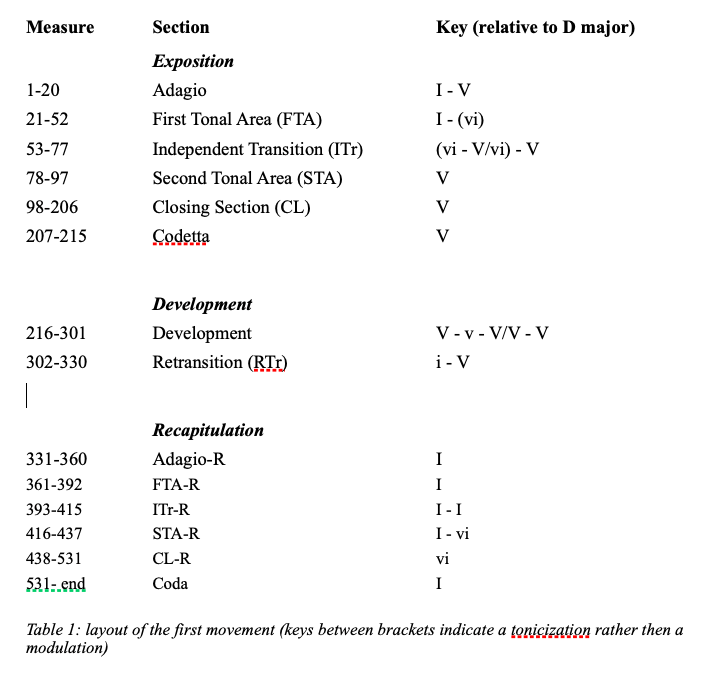
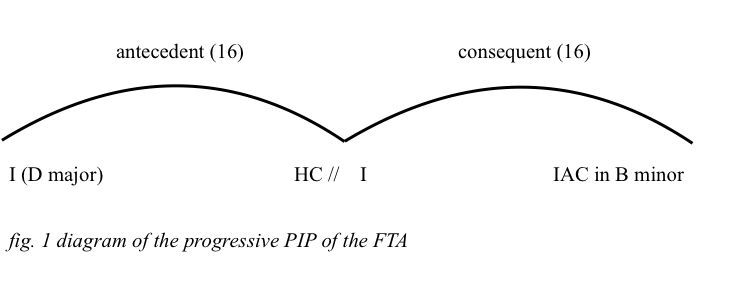


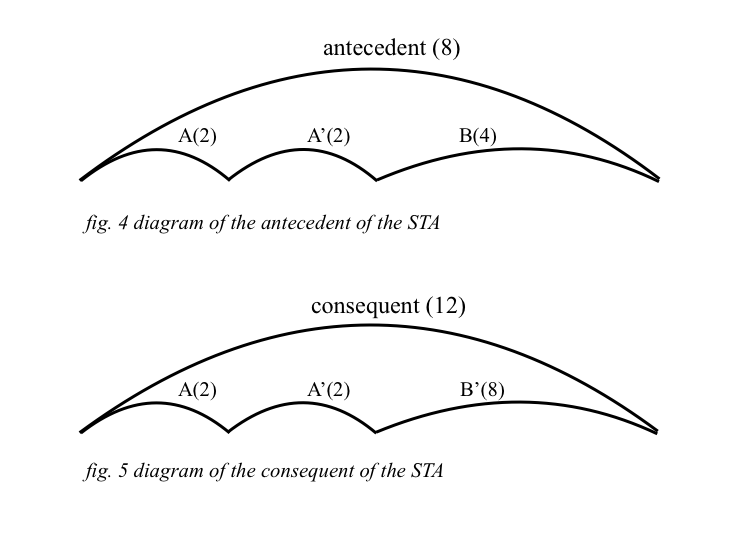
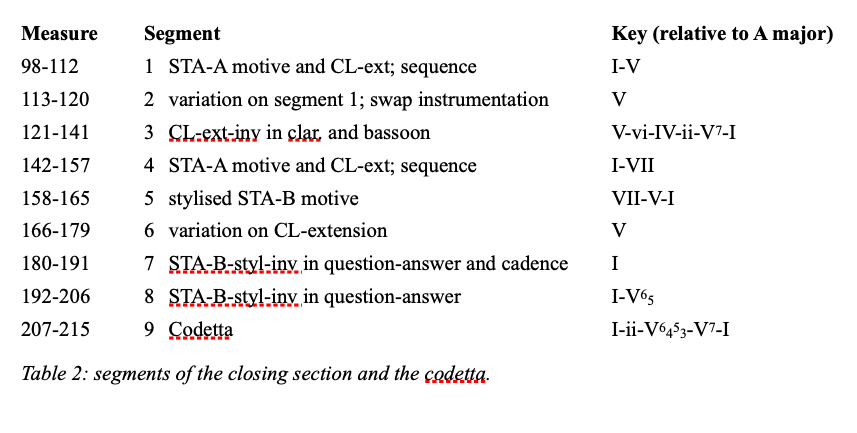



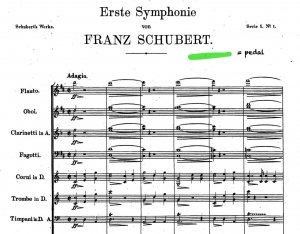



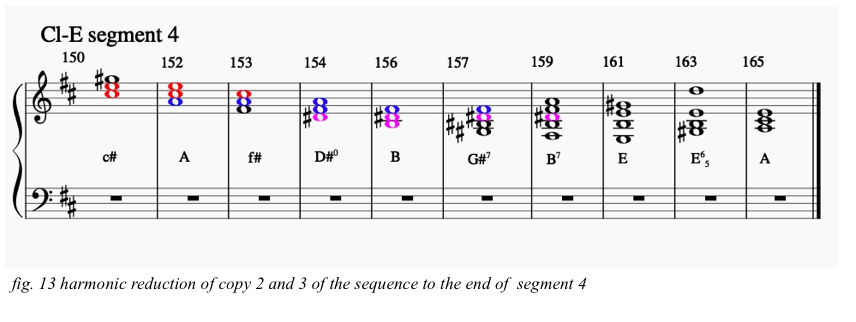

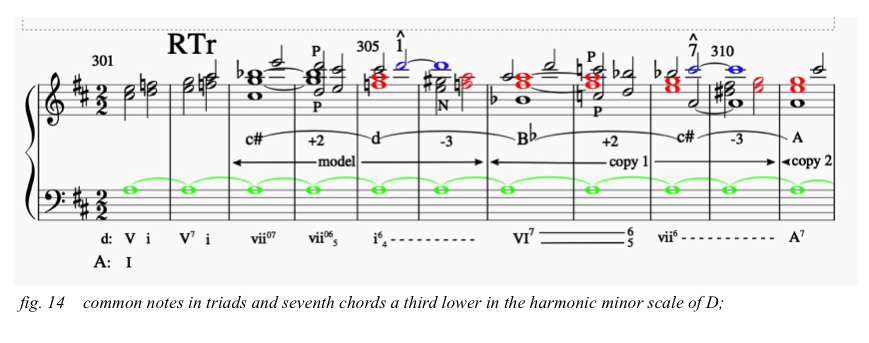
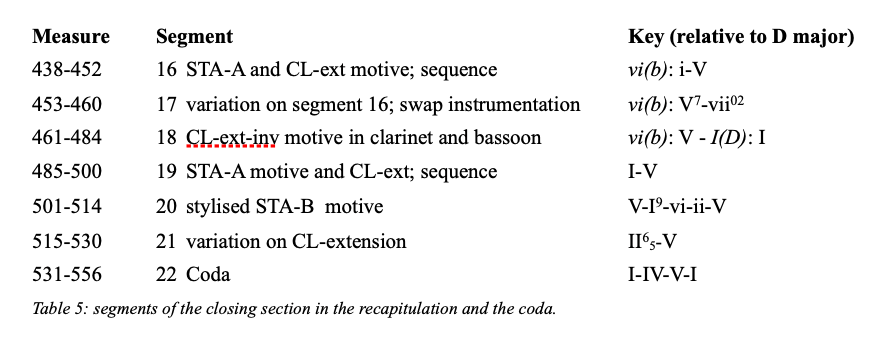
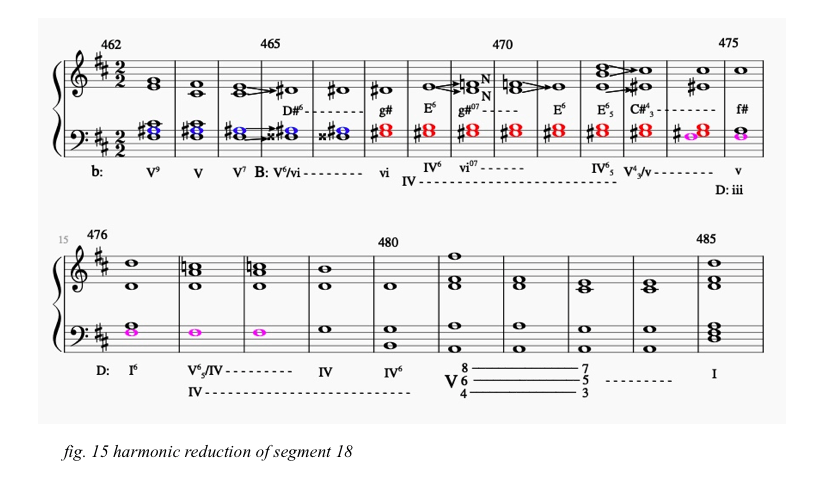
It’s interesting to see how Schubert struggled to stay in D major in the recapitulation. Although B minor is very closely related, it’s easy to see the lengths composers will go through to have that modulating effect in the transitions. Beethoven goes to the paralel major in the FTA in his ninth’s symphony, Berlioz has at one point stayed at the dominant for his FTA to modulate to the tonic in the STA… It’s almost as if for some composers not modulating is harder than modulating itself!